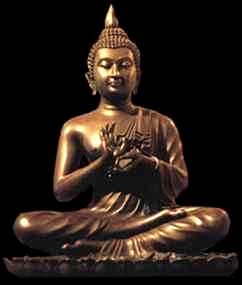Buddhist Philosophy based on the Rice-Seedling Sutra
(Salistamba Sutra)
[ pages in process ]
Topga Rinpoche
Twelve Links of Dependent Arising

Introduction
The teaching is concerned with the sutra called the Rice-Seedling Sutra, which is one of the first teachings given by the historical Buddha Shakyamuni. This sutra can, therefore be considered to be the basis of all Buddha's teachings.
Many of you who have come to this course are already familiar with Buddhist teachings but some of you are new. In either case the teachings of this sutra will be very beneficial.
For both the teacher and the students it is very important to have a good motivation during the teachings. For the teacher it is very important to bring to mind the kindness of the Buddha himself who originally gave the teachings and to apply his intelligence to comprehend the sense of the teachings. For the students it is essential to take the teachings without trying to compete with one another , being jealous of the progress of others or proud of ones own progress. It is important that one does not involve oneself in these negative emotions. The Buddha himself is a perfect being who has attained enlightenment, therefore the teachings he has given are words of truth. In that sense they are ultimate and both teacher and student should keep this in mind. As a result, the influence of these words of truth will enter ones mind so that it becomes free of obscurations.
Buddha gave different cycles of teachings. The first was about the Four Noble Truths.[1] Today's sutra belongs to the second cycle of teachings which is mainly concerned with presenting emptiness, the fact that all phenomena are essenceless, insubstantial and unreal.
[1. en.wikipedia.org/wiki/Four_Noble_Truths ]
The name of the sutra is The Rice-Seedling-Sutra. From among the Theravada and Mahayana traditions it belongs to the Mahayana tradition. Buddha himself was an individual who had complete and perfect realisation of emptiness, however, in terms of other beings their capacities to understand and realise this vary. There are some who are able to relate to these teachings on emptiness and some who are not able to relate to them. In order to make these teachings comprehensible the Buddha used the analogy of a rice-seedling when attempting to explain emptiness. Looking at a rice-field nearby the Buddha spoke of the growth of a rice-seedling and the associated process as an example to illustrate what is called dependent occurrence. He used this analogy in order to make the teachings easily comprehensible for different kinds of people who might otherwise, due to their inferior intelligence, have difficulties to understand these teachings. The Buddha pointed out that when one sows a seed in a rice-field that seed will grow into a rice-seedling in a process involving different steps. However, in essence all the different elements of that process are empty of reality.
The Sutra goes on saying: To all Buddhas and Bodhisattvas I bow down.
This is related to the translation of the sutra. The person involved in translating the sutra would pay homage in the beginning to all Buddhas and Bodhisattvas.
The sutra says: Once I heard these words told to me. The point made here is that one of the main disciples of the Buddha, in this case Shariputra, received these teachings directly from the Buddha. He experienced or came to an understanding through studying the teachings and its meaning, so this indicates that the teachings have an authentic source.
Then follows information on the place where the sutra was given, the people who were present and the time the sutra was given.
Start with Part 1: rice-seedling-01.htm